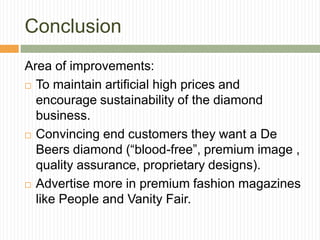De Beers' as a Monopoly
- 1. LEV LEVIEV VS. DE BEERS Nikhil Agarwal | Navneet Kumar | Saurabh Kumar | Sachin Pal
- 2. Introduction – De Beers Who is de beers? Not retailer Not manufacturer They are miner and buyer of 70% of the world’s rough diamonds. De beers is a South African company and was founded by Cecil Rhodes in 1888 by forming a cartel with the ten largest merchants in South Africa. By 1890, de beer controlled 95% of the world diamond production. The company spends $180million a year world wide to advertise cut diamonds.
- 3. De Beers as a Monopoly De beer was almost the sole seller of diamond. Sells a commodity with no close substitute. De Beers took control of all aspects of the world diamond trade in 1989. The main principle of de beer’s business model was to match the supply of diamonds with demand. They could determine who could buy uncut stones, in what quantities and quality and decide which cutting centers to be used.
- 4. Decline of Monopoly In 1991, the Soviet Union (the world's second- largest diamond producer by value) collapsed. Involvement in a 1994 price fixing case. In 1996, Australia's Argyle mine became the first major producer to terminate its contract with De Beers. Several rich diamond deposits were discovered in the Northwest Territories of Canada. Diamonds became tainted by the term “blood diamonds”.
- 5. Continued… High-handed treatment towards buyers. Alternative distributors came into prominence. Weakness in the economies of consuming regions. The results: De Beers controlled a shrinking share of output in a shrinking market. The resulting problems for De Beers helped to demonstrate the inherent instability of a cartel.
- 6. Role of Lev Leviev Converted De Beers Monopoly into duopoly. Opened his own cutting factory in 1977. Former sight-holder of De Beers. 1st dealer to operate across the value chain – from mining to polishing & retailing.
- 7. Continued… Russia Angola Namibia • Close to Vladimir • World’s 3rd • Paid $30 million to Putin. largest acquire 37% of producer of rough Namibian Minerals • Brokered meetings diamonds. Corp.(diamond between Russian mining President & Israeli • Invested $60 million outfit). Politicians. in exchange for 16% • Opened a polishing • Formed a joint of factory on Namibian venture Angola’s largest coast. with Russia’s state- diamond mines. run diamond mining & • Gave 51% share of selling group : RUIS. Ascorp. To Angolan govt. • By 2003, Leviev
- 8. Reorientation Strategies Trying to sell its existing products through marketing and branding. De Beers unveiled two branding initiatives – Forevermark and De Beers name itself. It employed the "Supplier of Choice" strategy putting them in direct competition with its sigh- holders. Started joint initiatives with its sight-holders. Buying other mining firms.
- 9. Conclusion Area of improvements: To maintain artificial high prices and encourage sustainability of the diamond business. Convincing end customers they want a De Beers diamond (“blood-free”, premium image , quality assurance, proprietary designs). Advertise more in premium fashion magazines like People and Vanity Fair.
- 10. THANK YOU
Editor's Notes
- Beginning course details and/or books/materials needed for a class/project.
- A schedule design for optional periods of time/objectives.
- Objectives for instruction and expected results and/or skills developed from learning.
- Relative vocabulary list.
- A list of procedures and steps, or a lecture slide with media.
- Example graph/chart.
- Conclusion to course, lecture, et al.










